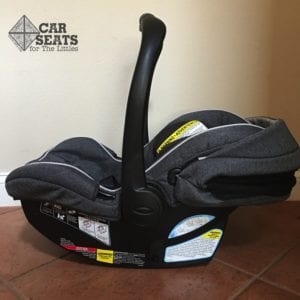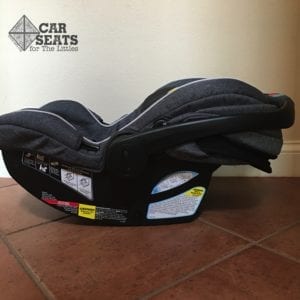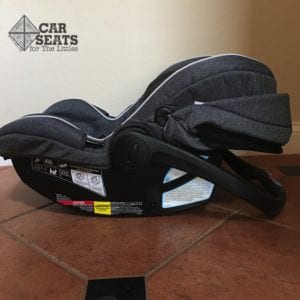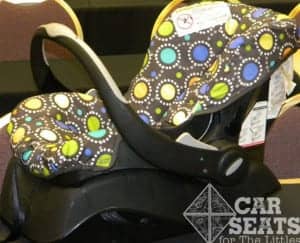“The handle must be up because it protects the baby in a rollover crash.”
We can’t quite pinpoint where this particular rumor came from. It seems to go back to the early 2000’s. Some car seats have designed the handle to act as a rebound control, but certainly not all of them.
“The handle must be down because that is how it locks into place.”
The origin of this rumor is a little easier to pinpoint. The rear facing only car seat has changed many times since it was first released. The earliest models didn’t include a base. Today, the base is a standard feature. The first
Century made the first rear facing only car seat sold with a base that stayed in the car in the 1980s. This seat, required that the handle be in the “down” position because the seat locked into the base with the handle in the lowest position. Most other manufacturers followed suit and required that the handle on their seats be down as well.
“A police officer told me it’s against the law for it to be up”
Some well-intentioned CPSTs and public safety officials have latched onto this “rule.” It traces back to seats that did have this requirement – however, it’s completely false. There is not a law in any state that regulates the position of an infant seat handle. Most simply require the seat to be used according to the manufacturer’s directions.
Here’s the Scoop
Each seat has different rules for where the handle can be. As always, your car seat’s manual is your most powerful and informative tool about the correct handle position or positions. For quick reference, we have made a chart showing the handle positions are permitted for each rear facing only car seat.
Here are the most common handle positions
Carry Position
This first picture shows the carry position. Different car seat manufacturers use names for this position but carry describes the position well. When the handle is in this, most upright position, it’s easiest to carry the car seat around.
Convenience Position
The second handle position is often called the convenience position. This puts the handle closer to the portion of the car seat where the child’s head will be.
Travel Position
The third position is often called the travel position. The carrier handle is at the top of the child’s head.
Stand Position
The fourth position is called the stand position. This position places the handle completely behind the head of the car seat and keeps the car seat from rocking when placed on the floor.
Rebound Position
The final handle position is called the rebound position. This position places the handle down towards the child’s feet.
Handle Positions- USA Only
| Manufacturer | Model | Allowed Position(s) | Notes |
|---|---|---|---|
| 4Moms | All | Carry | There are 2 handle positions. |
| Baby Trend | All | Any | Retroactively allows any locked position. Baby Trend still recommends keeping the handle back if possible. |
| Britax | All | Any | |
| Chicco | All | Any | There are 3 handle positions. |
| Combi | All | Carry | There are 3 handle positions. |
| Cybex | Aton 1, 2, Q | Carry | There are only 3 positions on the Aton 1 and 2. |
| Cybex | Cloud Q | Rebound (known as Drive) | There are 6 handle positions. |
| Dorel | All (Cosco, Maxi-Cosi, Eddie Bauer, Safety 1st) | Carry (Upright)* | *Follow the manual for each seat. Dorel is moving to all handles upright, but it is NOT retroactive. |
| Evenflo | Embrace 35 (and SensorSafe version), Snugli | Travel or Rebound | Requires 1.5" of clearance between any part of the child restraint and the seat in front of it. |
| Evenflo | Embrace, Discovery | Travel or Stand | Evenflo refers to the travel position as the "car" position. Requires 1.5" of clearance between any part of the child restraint and the seat in front of it. |
| Evenflo | Nurture, Serenade, SecureRide | Travel or Stand or Rebound | Evenflo refers to the travel position as the "car" position. Requires 1.5" of clearance between any part of the child restraint and the seat in front of it. |
| Evenflo | LiteMax | Travel or Carry | Requires 1.5" of clearance between any part of the child restraint and the seat in front of it. |
| GB | Asana 35 DLX | Any | |
| Graco | All | Any | |
| Hauck | All | Any | There are 5 positions. All are allowed in the vehicle. |
| Ingenuity | Intrust | Travel | There are 3 handle positions. |
| Orbit Baby | All | Travel | The Orbit has soft handles. |
| Peg Perego | Primo Viaggio 30/30 | Travel | |
| Peg Perego | Viaggio 4/35 | Any | Must use rebound position if installed baseless. With base, any locked position allowed, but prefer travel. |
| Phil and Teds | Alpha | Any | Also marketed as Mountain Buggy Protect. |
| Recaro | Coupe | Any | Discontinued |
| Summer Infant | Prodigy | Any | Discontinued |
| UPPAbaby | Mesa | Any | There are 3 handle positions. |
| Urbini | All | Any |





